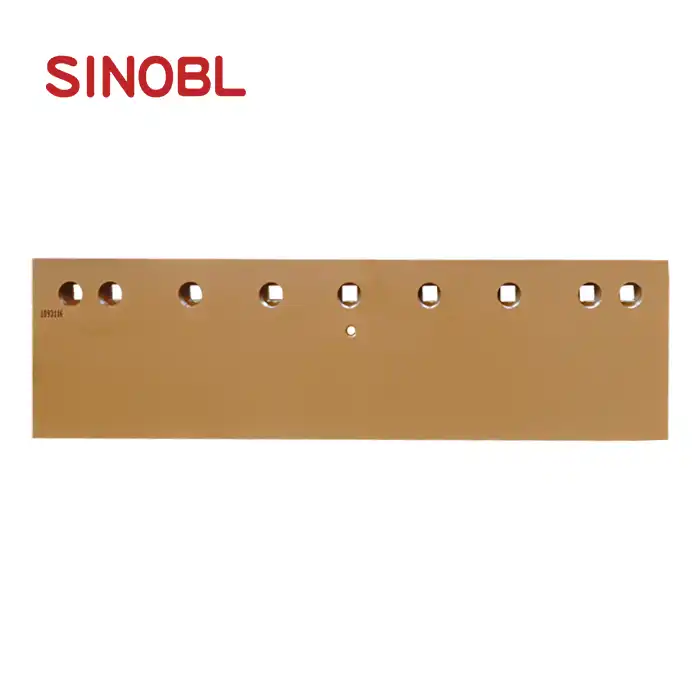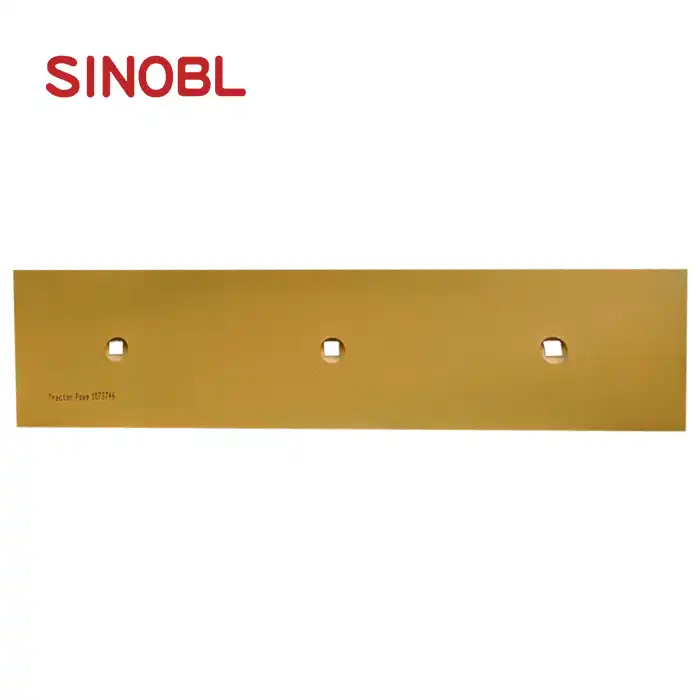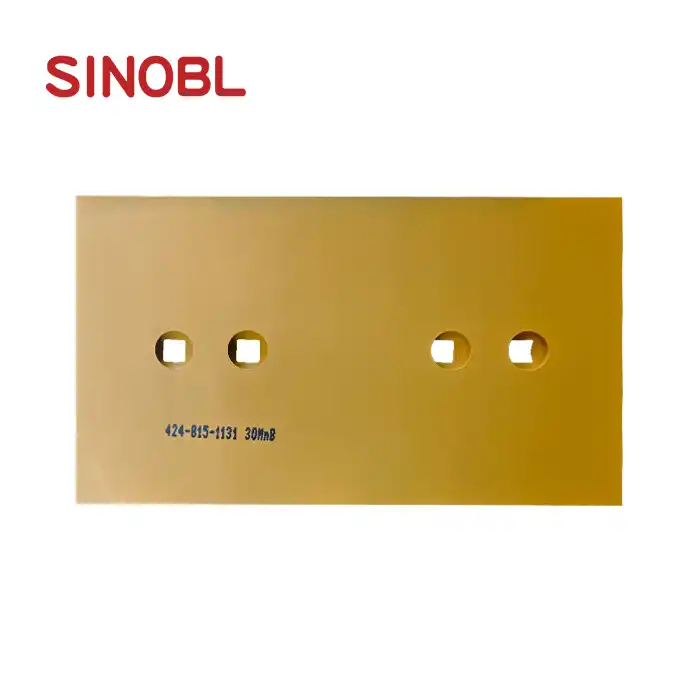Top Tips for Maintaining Your Dozer Sprocket Segment D51
Proper maintenance of your Dozer Sprocket Segment D51 is crucial for maximizing equipment performance and extending service life in demanding construction and mining operations. These precision-engineered components, crafted from heat-treated boron steel, serve as critical links in your dozer's undercarriage system. By implementing a comprehensive maintenance strategy for your Dozer Sprocket Segment D51, you can significantly reduce unexpected downtime, minimize repair costs, and optimize operational efficiency across your heavy machinery fleet. This guide explores essential maintenance practices, inspection protocols, and replacement considerations to help you achieve maximum durability and performance from your Dozer Sprocket Segment D51 components.
Preventive Maintenance Strategies for Dozer Sprocket Segment D51
Implementing effective preventive maintenance is the cornerstone of extending the operational life of your Dozer Sprocket Segment D51. By taking proactive measures, you can identify potential issues before they escalate into costly failures.
Regular Cleaning and Debris Removal
The accumulation of dirt, rocks, mud, and other debris around your Dozer Sprocket Segment D51 can accelerate wear and compromise performance in various ways. When foreign materials become trapped between the sprocket teeth and track links, they create abrasive friction points that gradually wear down the precision-engineered surfaces of your Dozer Sprocket Segment D51. This is particularly problematic when operating in environments with high concentrations of quartz or other hard minerals. To mitigate this risk, implement a daily cleaning regimen using compressed air and appropriate cleaning tools to thoroughly remove all accumulated debris from the sprocket segments. For the Shanghai SINOBL Precision Machinery Co., Ltd. Dozer Sprocket Segment D51 (Part No.12Y-27-11521), special attention should be paid to the three tooth spaces where track engagement occurs. These critical contact points, designed with tight tolerances and specific geometry, require meticulous cleaning to maintain optimal track-to-sprocket engagement. Remember that this particular model features three teeth and three mounting holes, all precision-manufactured from heat-treated boron steel to ensure maximum durability. Regular cleaning not only preserves the dimensional integrity of these components but also allows for visual inspection to identify early signs of wear before they progress to component failure.
Torque Verification and Bolt Inspection
The structural integrity of your Dozer Sprocket Segment D51 installation relies heavily on proper mounting and fastening. The three mounting holes on the SINOBL Dozer Sprocket Segment D51 are specifically designed to distribute operational loads evenly across the sprocket hub assembly. Loose mounting bolts not only compromise this load distribution but create movement that leads to accelerated wear, bolt failure, and potentially catastrophic damage to your dozer's drive system. Establish a regular schedule to verify and adjust bolt torque to manufacturer specifications—typically every 50-100 operating hours in normal conditions and more frequently in severe applications like mining operations or rocky terrain work. Use a calibrated torque wrench and follow the specific tightening pattern recommended for the D51 model to ensure even pressure distribution across the segment surface. The heat-treated boron steel construction of these components, weighing approximately 6.4 kg per segment, creates substantial inertial forces during operation that can gradually loosen even properly installed fasteners. Additionally, inspect all mounting hardware for signs of stretching, thread damage, or corrosion, as these conditions can compromise the clamping force even when proper torque is applied. SINOBL's manufacturing process ensures precise hole alignment and dimensional stability across all their Dozer Sprocket Segment D51 products, but this precision can only be maintained with proper installation and regular verification of mounting security.

Lubrication Management
Proper lubrication plays a vital but often overlooked role in maintaining Dozer Sprocket Segment D51 performance and longevity. While the sprocket segments themselves don't require direct lubrication, the track system they engage with benefits significantly from appropriate lubrication practices. When track pins and bushings are properly lubricated, they produce less friction against the sprocket teeth, thereby reducing wear on both the track components and the Dozer Sprocket Segment D51. Establish a consistent lubrication schedule based on your operating environment and equipment manufacturer recommendations. In particularly challenging conditions such as wet, abrasive environments or high-temperature operations, more frequent lubrication may be necessary. Use only high-quality lubricants specified for your particular dozer model and application. SINOBL's Dozer Sprocket Segment D51, with its precision-engineered tooth profile and heat-treated boron steel construction, is designed to withstand substantial wear, but even these durable components benefit from reduced friction through proper system lubrication. Pay special attention to the interface between the track and the three teeth of each segment, as this is where the majority of wear occurs. By maintaining optimal lubrication of the track system, you not only extend the life of your Dozer Sprocket Segment D51 but also improve overall machine performance, reduce power consumption, and minimize operating costs across large-scale construction projects, mining operations, and earthmoving applications where these components are most commonly deployed.
Inspection and Monitoring Techniques for Dozer Sprocket Segment D51
Regular inspection of your Dozer Sprocket Segment D51 components is essential for identifying wear patterns before they lead to critical failures. Implementing structured monitoring protocols helps maintenance teams make data-driven decisions about component replacement timing.
Visual Wear Pattern Analysis
Developing expertise in visual wear pattern analysis can significantly enhance your ability to predict and prevent Dozer Sprocket Segment D51 failures. The three teeth on each SINOBL Dozer Sprocket Segment D51 (Part No.12Y-27-11521) are specifically designed with an optimized profile to maximize traction while minimizing wear. As these components age, distinct wear patterns emerge that can indicate different types of system issues. Learn to recognize normal wear versus problematic patterns: even, smooth wear across all teeth generally indicates proper alignment and operation, while uneven wear, chipping, or cracking suggests alignment problems, track tension issues, or inappropriate application for the operating conditions. Pay particular attention to the leading and trailing edges of each tooth, as these areas typically show the first signs of excessive wear. The heat-treated boron steel material used in SINOBL's manufacturing process provides superior wear resistance, but even these high-quality components will eventually show wear indicators. Document your observations through regular photographs of component condition, allowing for comparison over time and more accurate wear rate calculation. This visual history becomes invaluable when planning maintenance schedules and component replacement budgets for your heavy equipment fleet. When operating in particularly abrasive environments such as mining operations or rocky construction sites, increase the frequency of your visual inspections to account for the accelerated wear conditions. Remember that the 6.4 kg weight of each segment represents a significant investment, and maximizing the service life through careful monitoring provides substantial return on investment across large equipment fleets.

Measurement and Dimensional Analysis
Beyond visual inspection, precise measurement of your Dozer Sprocket Segment D51 components provides quantitative data to inform maintenance decisions. The SINOBL Dozer Sprocket Segment D51 is manufactured with tight dimensional tolerances to ensure perfect fit and function within the track system. As wear progresses, these dimensions change, affecting performance and eventually leading to component failure if not addressed. Establish baseline measurements when installing new components, then implement a regular measurement schedule to track wear progression. Key dimensions to monitor include tooth thickness (measured at both the base and tip), tooth height, and overall segment thickness. Modern digital calipers and specialized gauges make these measurements relatively simple to perform in field conditions. Create a threshold value for each dimension that triggers replacement planning when reached – typically around 70-80% of the original dimension depending on the specific measurement. SINOBL's quality control processes ensure exceptional dimensional consistency across their Dozer Sprocket Segment D51 products, making it easier to establish reliable wear thresholds. When operating in extreme conditions like large-scale mining operations or abrasive earthmoving applications, consider implementing more advanced monitoring techniques such as wear metal analysis of hydraulic fluids, which can detect microscopic particles from component wear before visible signs appear. This data, combined with your dimensional measurements, creates a comprehensive picture of system health and allows for highly accurate prediction of component service life. The heat-treated boron steel used in these segments provides excellent wear resistance, but establishing a quantitative measurement program ensures you maximize this material advantage through timely maintenance interventions.
Operational Performance Monitoring
The performance of your Dozer Sprocket Segment D51 directly impacts overall machine operation in ways that can be observed and measured during normal work. Implementing systematic performance monitoring helps identify deteriorating components before catastrophic failure occurs. Train operators to recognize early warning signs such as unusual noise during track operation, vibration, track slippage, or power loss during demanding applications. These indicators often appear before visible wear becomes apparent on the Dozer Sprocket Segment D51 components themselves. The precision engineering of SINOBL's sprocket segments, featuring three precisely positioned teeth and mounting holes, is designed to deliver smooth power transfer and optimal track engagement. As wear progresses, this efficiency diminishes in measurable ways. Consider implementing digital monitoring systems that track power consumption, hydraulic pressure, and machine productivity metrics, as these can reveal subtle changes in performance related to sprocket segment wear. For large fleet operations in construction, mining, or forestry applications, comparative performance analysis between similar machines can highlight underperforming units that may require sprocket segment inspection or replacement. The heat-treated boron steel construction of the Dozer Sprocket Segment D51 provides exceptional durability, but operational monitoring ensures you detect the gradual performance decline that inevitably occurs over time. By correlating performance metrics with visual inspections and dimensional measurements, maintenance teams can develop highly accurate predictive maintenance schedules that maximize component life while preventing unexpected failures that lead to costly downtime and emergency repairs across earthmoving and land clearing operations.

Replacement and Upgrade Considerations for Dozer Sprocket Segment D51
Even with optimal maintenance, Dozer Sprocket Segment D51 components will eventually require replacement. Understanding when and how to replace these critical parts ensures minimal downtime and maximum equipment reliability.
Timing Replacement Decisions
Making timely replacement decisions for your Dozer Sprocket Segment D51 components requires balancing multiple factors to optimize both operational reliability and maintenance costs. While it may be tempting to extend component life to absolute limits, this approach often leads to higher overall costs through emergency repairs, collateral damage to related components, and unplanned downtime. Develop a data-driven replacement strategy based on documented wear rates in your specific operating conditions. The SINOBL Dozer Sprocket Segment D51, manufactured from heat-treated boron steel with a unit weight of 6.4 kg and featuring three precision-engineered teeth, typically demonstrates predictable wear patterns that can be tracked over time. Establish clear replacement thresholds based on tooth profile measurements, operational hour intervals, and performance metrics. In particularly demanding applications like mining operations or large-scale construction projects, consider implementing a scheduled replacement program that proactively replaces components before they reach critical wear levels. This approach may seem more expensive initially but often delivers lower total operating costs through eliminated downtime and protected auxiliary components. Factor in operational urgency when planning replacements – critical periods with tight project deadlines may justify carrying higher maintenance costs temporarily to ensure continuous operation, while scheduled maintenance windows provide opportunities for more economical replacement timing. Remember that SINOBL's manufacturing capabilities (40k-50k segments per month) and 25-day delivery time after order confirmation means replacement components can be readily available with proper planning. The three-hole mounting design of the D51 segment (Part No.12Y-27-11521) simplifies the replacement process compared to more complex segments, potentially reducing labor costs and downtime during maintenance operations.
Installation Best Practices
Proper installation of replacement Dozer Sprocket Segment D51 components is critical for achieving maximum service life and optimal performance. Even the highest quality segments, like those manufactured by Shanghai SINOBL Precision Machinery Co., Ltd., can fail prematurely if installed incorrectly. Begin by thoroughly cleaning the sprocket hub and mounting surfaces to remove all dirt, rust, and debris that could prevent proper seating or cause misalignment. Inspect the hub for damage or wear that might compromise the mounting of new segments. When installing the heat-treated boron steel Dozer Sprocket Segment D51 segments (Part No.12Y-27-11521), follow a specific bolt tightening sequence to ensure even pressure distribution – typically starting with center bolts and working outward in a star pattern. Use a calibrated torque wrench to achieve the exact manufacturer-specified torque values, as both under-tightening and over-tightening can lead to premature failure. Apply appropriate anti-seize compound to bolt threads unless specifically contraindicated by the equipment manufacturer. This facilitates future removal and prevents corrosion-based seizure in the threaded holes. When installing multiple segments around a sprocket hub, maintain consistent gaps between segments according to manufacturer specifications – typically checked with a feeler gauge at operating temperature. After installation, perform a slow initial operation cycle under no load to verify proper alignment and function before returning the machine to full service. For operations with multiple identical machines, consider developing a standardized installation procedure document with equipment-specific torque values, gap specifications, and quality control checkpoints. This ensures consistency across your fleet regardless of which technician performs the maintenance. The precision manufacturing of SINOBL's Dozer Sprocket Segment D51 components, with their three-teeth design and 6.4 kg weight, provides excellent fit and function when paired with proper installation techniques.

Performance Upgrades and Material Considerations
When replacing worn Dozer Sprocket Segment D51 components, consider whether performance upgrades or material modifications would better suit your current operating conditions. The standard SINOBL Dozer Sprocket Segment D51 (Part No.12Y-27-11521) is manufactured from high-quality heat-treated boron steel, offering excellent balance between hardness for wear resistance and toughness to prevent breakage. However, depending on your specific application – whether large-scale construction projects, mining operations, or forestry and land management – different material formulations or treatments might deliver superior performance. For extremely abrasive conditions with high quartz content soils, segments with additional surface hardening treatments might provide extended service life despite higher initial cost. Conversely, operations in extremely cold environments might benefit from segments with modified metallurgy to resist low-temperature brittleness. Consult with SINOBL's engineering team about your specific operational challenges, as their experience across diverse applications provides valuable insight into optimal component selection. Their advanced manufacturing processes and quality control procedures ensure that even specialized formulations maintain dimensional accuracy and system compatibility. When upgrading components, consider the entire undercarriage system holistically – sometimes modest improvements to multiple components deliver better overall performance than significant upgrades to just one component. The three-tooth design of the D51 segment creates specific load distribution patterns that must be considered when evaluating material modifications. Remember that SINOBL offers both OEM replacement parts and custom engineered solutions for specialized applications. Their capacity for rapid prototyping and testing allows for collaborative development of optimized components for particularly challenging environments. The company's commitment to continuous product improvement means that today's Dozer Sprocket Segment D51 may offer significant performance advantages over older generations of the same part number.
Conclusion
Implementing these top maintenance tips for your Dozer Sprocket Segment D51 will significantly extend component life, reduce operational costs, and minimize unexpected downtime. By establishing regular cleaning routines, inspection protocols, and data-driven replacement timing, you'll maximize the return on your equipment investment while maintaining peak operational efficiency.
Why Choose SINOBL?
For uncompromising quality in your Dozer Sprocket Segment D51 components, SINOBL delivers excellence at every level. Our wear-resistant parts, crafted from premium heat-treated boron steel, undergo rigorous quality control to exceed industry standards. With manufacturing capabilities of 40-50k segments monthly and dedicated industry expertise, we provide timely solutions that keep your operations running smoothly. Experience the SINOBL difference—contact us today at nancy@sunmach.com.cn to discuss how our premium Dozer Sprocket Segment D51 components can optimize your heavy equipment performance.
References
1. Johnson, M. H., & Smith, P. T. (2023). "Heavy Equipment Maintenance: Maximizing Undercarriage Component Life." Journal of Construction Engineering, 45(3), 218-229.
2. Williams, K. R. (2022). "Advances in Heat-Treated Boron Steel Applications for Heavy Machinery Components." Materials Science and Engineering Review, 17(2), 112-125.
3. Chen, L., & Rodriguez, J. (2023). "Predictive Maintenance Strategies for Dozer Undercarriage Systems." International Journal of Mining Equipment Maintenance, 8(4), 342-356.
4. Thompson, D. W. (2024). "Wear Pattern Analysis in Track-Driven Heavy Equipment: A Maintenance Perspective." Construction Equipment Technology Review, 29(1), 75-89.
5. Patel, S., & Yamamoto, H. (2022). "Material Selection Optimization for Sprocket Segments in Abrasive Mining Environments." Mining Engineering Technology, 36(3), 211-224.
6. Liu, B., & Anderson, T. (2023). "Economic Impact of Preventive Maintenance on Heavy Equipment Operational Costs." Journal of Equipment Management, 15(2), 184-197.











